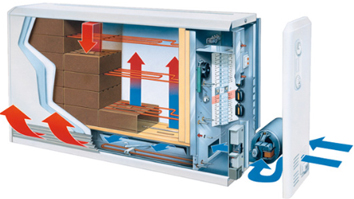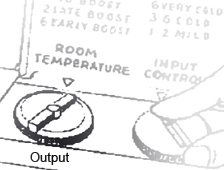Storage Heater Repairs
5 Common Problems
Storage Heaters Asbestos
Old vs New Storage Heaters
Economy 7
How Storage Heaters Work
Installation Instructions
Storage Heater Controls
Running Costs
Storage Heater VS
Electric Radiator Costs
Comparison
How to Buy
Topics
Storage Heaters OR
Gas Central Heating
Old Storage Heater Problems
Storage Heater KW
Solar Storage Heaters
Office Storage Heaters
Smell of Fumes
Storage Heater Directory
History of Storage Heaters
Environmental Performance
Future
Spare Parts
Brands
Dimplex
Dimplex range
Dimplex Quantum Heaters
Dimplex Reviews
Creda
Creda range
Stiebel Eltron
Sunhouse
Unidare
Elnur
Newlec
Fan assisted storage heaters
Service
Contact Us or Ask An Expert
Questions
How Storage Heaters Work...
How storage heaters work is very straight forward.
Electricity to the units is restricted to off peak hours. When 'on', electricity heats the elements, which in turn heat the bricks.
Although surrounded in a layer of insulation as the brick get hotter the casing of the heater becomes hotter. Essentially it is the heat from the casing that heats the room.
In recent years additional heat is released from the heater by the operation of a damper valve or output control. The basis of how storage heaters work is simple although often misunderstood.

Yes it takes energy at night time and first thing in the morning it's at it's hottest, but - it's overnight when outside temperatures are coldest. As the day progresses the bricks become cooler and hence the heat output decreases. But this is exactly what is needed as the outside temperature is rising.
In the evening the casing is becoming cool, there is no doubt most of the heat has been expended. However the storage heater has done its job pretty well in that the fabric of the room walls act like a large storage heater maintaining comfort.
There is no doubt if the external temperature in the evening drops suddenly the storage heater may be found wanting and this is when the Output controls comes in to play as will be explained later.
How Storage Heaters Manual Controls Work
Storage heaters are very straight forward to adjust. Essentially every heater has 2 controls, an Input control and an Output control.
The main control is the Input control. Input control determines the level of heat stored over night and hence the heat of the casing.
The setting of the Input control will have the greatest influence on the level of comfort and also on the running costs. Like the control on a cooker, the higher the setting the more heat stored and hence the more heat released. Maximum setting will certainly be needed in winter but it can be reduced in autumn and spring for more economical operation.
The Output or 'boost control' plays a smaller but none the less important role.
 The original storage heater just released heat from the casing. Off peak periods were typically long 11 or even 15 hours per day. However when Economy 7 was promoted in the 1980's manufacturers sought to release as much of the heat stored in the brick as possible. To this end the damper valve or Output control was developed. When the damper control or Output control is opened air directly enters the brick core and is released from the grille at the top of the heater.
The original storage heater just released heat from the casing. Off peak periods were typically long 11 or even 15 hours per day. However when Economy 7 was promoted in the 1980's manufacturers sought to release as much of the heat stored in the brick as possible. To this end the damper valve or Output control was developed. When the damper control or Output control is opened air directly enters the brick core and is released from the grille at the top of the heater.
The Output control is now operated by a piece of bimetal so that only when the brick core is cooling down the damper valve will open to release the last of the stored heat. The use of the bimetal allows the Output control to be set in one position and then operate automatically day after day. Set to minimum the Output control will not operate the damper valve. Set to maximum it will enable the bimetal to open the valve in the afternoon, suitable for commercial premises. For domestic customers a setting in between 'min' and 'max' will open the damper valve in the early evening.
This Output control causes the most confusion in terms of customer understanding. In reality it only controls about 10% or 15% of the total amount of stored heat and only releasing this as the brick themselves become cooler. However some customers think turning the Output to minimum should result in no heat being released whatsoever but of course 85% to 90% of the heat is provided from the hot casing and is controlled by the Input control.
